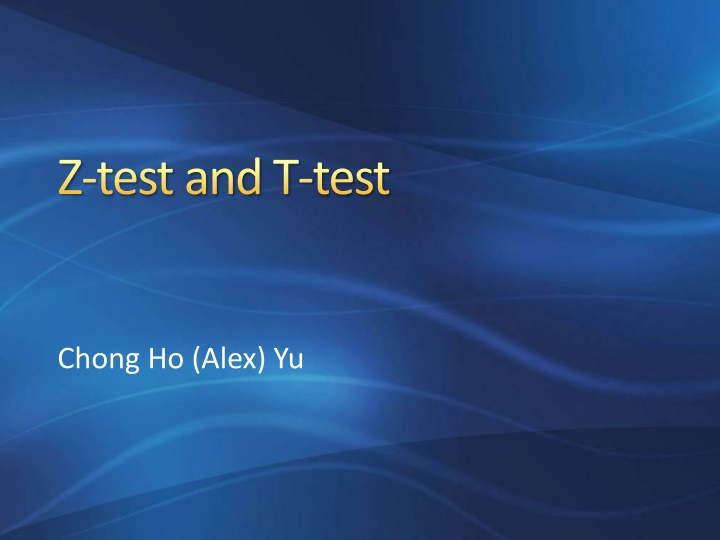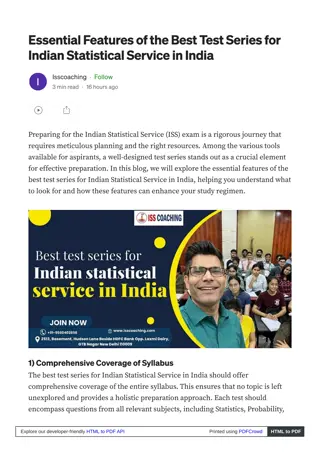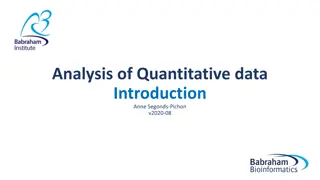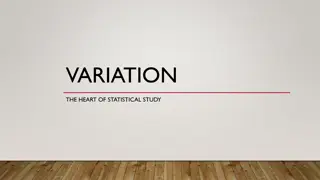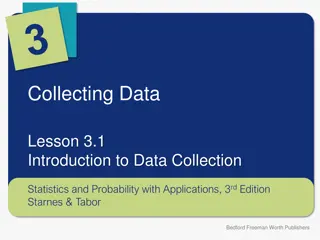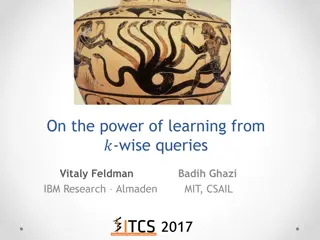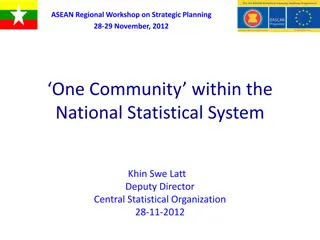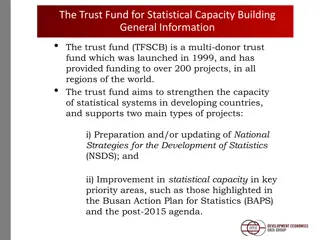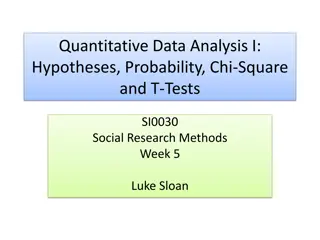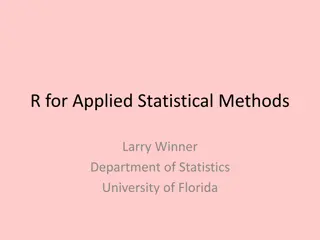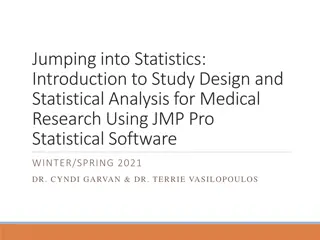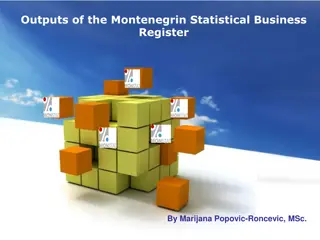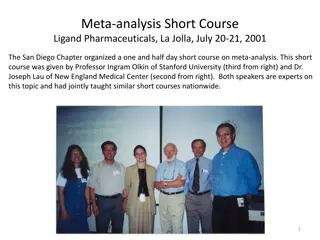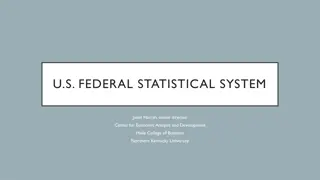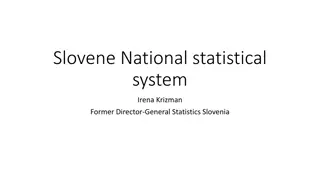Z-test and T-test in Statistical Analysis
Z-test and T-test are statistical tests used to compare sample data with population parameters or between different samples. Z-test requires knowledge of population variance, making it less commonly used, while T-test is more flexible for small sample sizes. In a real-world example, a superintendent compares student SAT scores to the state average using a one-sample T-test, indicating the probability of obtaining the results if the null hypothesis is true.
Download Presentation

Please find below an Image/Link to download the presentation.
The content on the website is provided AS IS for your information and personal use only. It may not be sold, licensed, or shared on other websites without obtaining consent from the author.If you encounter any issues during the download, it is possible that the publisher has removed the file from their server.
You are allowed to download the files provided on this website for personal or commercial use, subject to the condition that they are used lawfully. All files are the property of their respective owners.
The content on the website is provided AS IS for your information and personal use only. It may not be sold, licensed, or shared on other websites without obtaining consent from the author.
E N D
Presentation Transcript
Z-test and T-test Chong Ho (Alex) Yu
Z-test A statistical test for which the test statistics can form a normal distribution owing to the central limit theorem. Rarely used (I never used it in my whole life, so far). Why? You can run a z-test if and only if the population variance is known. But how often do you have access to the population-level information? Let s skip it.
One-sample t-test One-sample t-test Test the sample mean against the population mean To see whether there is a big gap between the sample and the population To see whether the sample comes from or belongs to the population.
Revisit the same example In California the average SAT score is 1500. A superintendent wanted to know whether the mean score of his students is significantly behind the state average. 50 students Average SAT score =1495 Standard deviation is 100 You don t need a commercial software app. There are many online stat calculators e.g. https://www.graphpad.com/quickcalcs/OneSam pleT1.cfm?Format=SD
Pvalue Simplified explanation: what is the probability (chance) of obtaining this test statistics in the long run given that the null hypothesis is true? The so-called performance gap between his students and the state average is 5 points only. If this happens by chance alone, it would be about 7 out of 10 times (p = .7252). It is not an extraordinary phenomenon. He should side with the null hypothesis: There is no significant performance gap between his students and others.
Online one-sample t-test calculator You are not sure whether the true performance gap between your students and others is exactly 5. It could be as low as -33.42 or as high as 23.42.
One-sample t-test in SPSS JMP needs more steps for 1-sample t-test and so we will do it in SPSS only. Open between_within.sav
One-sample t-test in SPSS Assume that at the university the average midterm score in psychology is 90. I want to know whether there is any significant difference between the average midterm score of my student and that of all psychology majors.
One-sample t-test in SPSS The 2-tailed p value is .038, which is less than .05. By chance alone, it could happen about 3.8 time out of 100 in the long run. There is a real performance gap!
Ungraded exercise Use the online one-sample t-test calculator: https://www.graphpad.com/quickcalcs/OneSam pleT1.cfm?Format=SD The average state annual household income is $65,000. In a sample of 500, the average county annual household income is $64,000. and the SD is 1,000. Is there a significant difference between the state average and the county average?
Two independentsample t-test You need two independent groups e.g. boys and girls. Test whether there is a performance gap between boys and girls
T-test T-test is a test to get the t-ratio. The difference between two means based on the standard deviation. Virtually any comparison test is about looking at the difference adjusted by a common standard Otherwise, it will be comparing apples and oranges!
Assumptions The observations (the behaviors of the participants) are independent (e.g. If students help each other in homework, then we cannot know their actual performance level). The values in the dependent variable are normally distributed. The variances (dispersion) of the two groups are similar.
2-independentsample t-testin SPSS Use the same data: between_within.sav
2- independentsample t-test in SPSS Use the same data: between_within.sav
2- independentsample t-test in SPSS Use the same data: between_within.sav
2- independentsample t-test in SPSS Before we look at the inferential statistics, we should look at the descriptive statistics first. The sample mean score of male students (85.88) is higher than that of females (72.29). The standard error (SE shows how much bias) of male mean score is lower than that of females. How many of you would say that boys are smarter than girls in terms of midterm test performance?
2- independentsample t-test in SPSS Before we look at the t-test result, we need to look at the Levene s test of equal (or unequal) variances. The p value (sig.) is .362. The null hypothesis is: there is no significant difference between the male and female variances. The data structure meets the assumption for t-test. Now we can proceed to look at the t-test result.
2- independentsample t-test in SPSS Because the variances are equal, we need to look at the first row only. The 2-tailed p value of the t-test is .142. Despite that male students outperformed female students by more than 13 points (85.88 - 72.29)., the t-test shows that there is no significant performance gap.
Ungraded exercise Use the data between-within Run a 2-sample independent t-test. Use the final as the DV Use sex (gender) as the IV Test whether the variances are equal before proceeding to the t-test. Report the confidence intervals and the p value. Is there any performance gap between boys and girls in final?
2 dependentsample t-test Also known as 2 correlated sample t-test Paired t-test Match-paired When you have no control group You are your own control. The person that is most similar to you is: YOU!
2-dependentsample t-test in SPSS The correlation between midterm and final is .6. It is significant (p = .017). Students who did well in midterm are likely to do well in the final, and vice versa.
2-dependentsample t-test in SPSS The two-tailed p value (sig.) is .196. In the standpoint of the professor, I expect learners can improve their performance from midterm to final. I want a one-tailed test! You can get that by manually divide the 2-tailed p value by 2. .196/2 = .098
Assignment 11 (Canvas) Use SPSS or JMP Use the data between-within Run a paired t-test Use test and midterm as the variables Spot and exclude students that show floor or ceiling effects, if there is any. Report the correlation coefficient, the confidence intervals and the p value Is there any significant change/growth between the test and the midterm?
